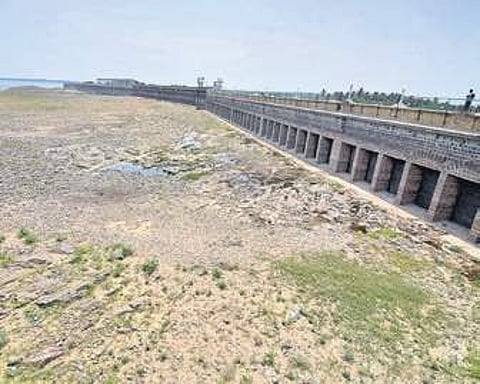

MYSURU: It’s been almost a month since the monsoon season officially set in, but the continued dry spell in many parts of the state has led to water levels in most major reservoirs depleting to alarming levels. The total quantum of water available in the four major reservoirs in the Cauvery basin, as of Saturday, is just about 14 tmcft.
The good rains last year had kindled hopes among farmers of the region, but now they are staring at another drought year and are struggling to save their standing crop as the Cauvery basin has so far received less than 40% of the normal rainfall. The poor rains have also affected farming activities and sowing has been taken up in less than 50% of the cultivable area.
Together, there is a deficit of about 50 tmcft of water in the Krishnaraja Sagar dam, Kabini, Hemavathi and Harangi reservoirs presently, compared to the corresponding period last year. In 2018, as much as 178.28 tmcft water had been released to Tamil Nadu from Kabini reservoir alone, considered the highest in last 34 years last year.
Agriculture Department Joint Director Mahantheshappa said sowing is completed in about 50% of the area. But it has come to a grinding halt as there has been no rains for the last couple of weeks. He feared that the farmers will be in deep trouble if there is no rains within a week as they may lose their kharif crop.
What is worrying is that Bhagamandala in Kodagu district, the birthplace of river Cauvery, has received only 567 mm of rainfall so far this year. But irrigation department officials and the farming community are pinning their hopes on the remainder of the monsoon season and feel that good rains in July should see reservoir levels increase and farming activities picking up.
READ HERE | By July, 90% farm loans to be waived off in Karnataka
In the corresponding period last year, Bhagamandala had received 2,436 mm of rainfall. Between January and December that year, it had recorded 7,500 mm of rainfall. In 2017, the region recorded 1,500 mm rainfall till June.
At Harangi reservoir, the water level stands at 2,807 ft against a maximum of 2859 ft, with 6.5 tmcft of water available, as there has been no rain in the catchment area. The failure of the monsoon in Wayanad region of Kerala has also affected inflow into Kabini reservoir. The water level on Saturday was 2,257.4 ft, as against a maximum of 2,284 ft, with less then 730 cusecs of inflow.
The situation at Krishnaraja Sagar reservoir is also scary with the water level at 79.8 ft as against the maximum of 124.8 ft, with just 4.5 tmcft of water stored. Last year, good rains had resulted in the water level rising to 106.2 ft with 22.5 tmcft of water available.
“We have prepared for sowing of ragi and pulses. We fear we may lose the tobacco crop, so we don’t want to take chances”, said Shivanna of Banikuppe in Hunsur taluk.
Though there has been some rainfall in Chikkamagalur and Sakaleshpur catchment area, the inflow at Hemavathi reservoir is not encouraging, with just 821 cusecs and the water level at 2,864.94 ft against the reservoir’s maximum level of 2,905 ft. The reservoir has 5.02 tmcft of water against maximum storage of 37 tmcft.
Sugarcane Growers’ Association president Kurubur Shantha Kumar said the prevailing condition is not farmer-friendly as there is not even enough water to meet the drinking water needs of the region.